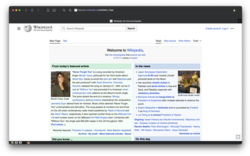iCab
 iCab 6.2.1 in dark mode on macOS Sonoma | |
| Developer(s) | Alexander Clauss |
|---|---|
| Initial release | February 17, 1999 |
| Stable release | 6.2.1[1] |
Feed reader | |
| License | Shareware |
| Website | icab |
iCab is a web browser for MacOS and Classic Mac OS by Alexander Clauss, derived from Crystal Atari Browser (CAB) for Atari TOS compatible computers.[2] It was one of the few browsers still updated for the classic Mac OS prior to that version being discontinued after version 3.0.5 in 2008;[3] Classilla was the last browser that was maintained for that OS[4] but it was discontinued in 2021.[5]
The downloadable product is fully functional, but is
Versions
iCab 2.9.9 supports both
iCab 2.9.8 runs natively on early versions of Mac OS X, but Mac OS X compatible versions of iCab 2.x are no longer officially available for download.
iCab 3.x can run on PowerPC systems running
iCab 4 was rewritten to use the
iCab 5 was released on June 12, 2012. It runs on Mac OS 10.5 or later.
iCab 6 was rewritten using the new technologies in macOS Big Sur and released on October 31, 2020. It runs on macOS 10.13 or later.
History
iCab was introduced in 1999. The first versions of iCab were criticized for not supporting
On 7 June 2009, iCab 4.6, using the WebKit rendering engine, became the first desktop browser released to display a score of 100/100 and pass the Acid3 test.[citation needed] Apple's Safari 4 browser was released one day later and has been officially credited as being the first official release browser to pass the Acid3 test with a score of 100/100.
Features
iCab features a filter manager which allows users to avoid downloading advertisements and other content. Currently iCab comes with two filters (advertisements and video). Other kinds of filters add features, such as the YouTube video filter which adds a download link on all YouTube page views.
iCab has features for
iCab's Download manager allows the user to start, stop, resume and review downloads. It maintains a download history, and supports downloading of an individual page, or a whole site (crawling) with many user-selectable crawl-constraint options. It can save as portable web archives (a ZIP archive containing HTML, images and other files), or as individual files on the local hard drive.
iCab also contains the following features:[10]
- Tabbed browsing.
- Javascript and CSS2support.
- Multiple language support, including Arabic on older Macs (cannot display UTF-16 pages).
- Filtering:
- Filtering out of images and plugin content (e.g. ads).
- Adjust rendering, network, JavaScript, and cookies settings for individual sites or types of pages.
- Kiosk mode: full-screen display and access controls.
- Acid2 test compliance.
- Configurable print dialog.
- History window which can sort by title, last access date, or URL.
- Hotlist (bookmark) mechanism which can automatically or manually check for updates to bookmarked sites.
- Reload a single image on a page without needing to reload the whole page.
- Disable web "annoyances" such as animated GIFsand embedded sound files.
- User agent spoofing(i.e. pretending to be another browser).
- Support for sessions (i.e. saving and then loading all open windows and tabs).
- Add any query (e.g., search engine, Wikipedia) to the toolbar search widget by point-and-click.
iCab Mobile
iCab Mobile is the mobile version of the iCab Web Browser for
See also
References
- ^ "iCab 6.2.1 (2023/05/05)". 5 May 2023. Retrieved 5 November 2023.
- ^ Patting, Sebastian (2011-11-22). "Interview with Alexander Clauss, iCab's Creator". Low End Mac. Retrieved 2016-09-07.
- ^ "iCab Download".
- ^ Smykil, Jeff (2009-07-13). "Browse the Web in style with Classilla for Mac OS 9". Ars Technica. Retrieved 2016-09-07.
- ^ Kaiser, Cameron (2021-03-29). "The final official release of Classilla". Old Vintage Computing Research. Retrieved 2021-09-27.
- ^ "Purchase/Register iCab". 2016-08-03. Retrieved 2016-09-07.
- ^ Savetz, Kevin (September 1999). "Browser Brawl". MacAddict. No. 37. pp. 32–38. The author mentions the lack of CSS2 and JavaScript support
- ^ Nielsen, Jakob (1999-02-23). "iCab: New Browser With Structural Navigation". Nielsen Norman Group. Retrieved 2024-01-21.
- ^ "iCab 4.0.1". Australian Macworld. No. 123. May 2008. p. 72-72.
- Wired. Retrieved 2016-09-07.
- ^ Viticci, Frederico (2013-07-23). "Launch URL Schemes with Gestures in iCab Mobile". MacStories. Retrieved 2024-01-21.
- ^ "iCab Mobile - The Internet Taxi for the iPhone, iPod Touch and iPad". icab-mobile.de. Retrieved 2024-01-21.
- ^ Writtenhouse, Sandy (2018-11-09). "iCab Mobile review: a different web browser for your iOS device". iDownloadBlog.com. Retrieved 2024-01-21.
- ^ Chavanu, Bakari (2014-04-12). "iCab: Another Powerful Alternative to Safari on the iPad". Make Use Of. Retrieved 2024-01-21.
- ^ Viticci, Frederico (2018-01-20). "Installing tvOS Betas Over-the-Air from iOS with iCab and Dropbox". Retrieved 2024-01-21.
